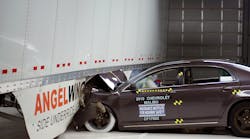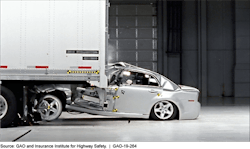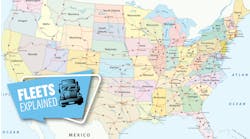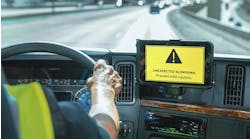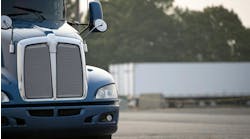After studying the efficacy of side underride guards for trailers, the National Highway Traffic Safety Administration is considering whether to require the safety devices for motor carriers. The agency, which estimates side underride guards would save lives, is seeking public feedback on the technology.
In an advanced notice of proposed rulemaking (ANPRM) on NHTSA’s website, the agency outlines the result of a study, mandated by the Infrastructure Investment and Jobs Act, on side underride guards. NHTSA completed the study in 2022 and estimated that about 17 lives would be saved and 69 serious injuries would be prevented annually if the guards were mandatory. The ANPRM will be published in the Federal Register in the coming weeks to receive public comment.
According to NHTSA, side underride guards are most effective at speeds of 40 mph or slower. At those speeds, fatalities are reduced by 97% and serious injuries are reduced by 85%. The agency estimated that every year there are 89 light vehicle occupant fatalities and 409 serious injuries in two-vehicle crashes with tractor-trailers where a light passenger vehicle strikes the side of a tractor-trailer and underrides it. However, only about 20% of those crashes occur at speeds of 40 mph or lower.
See also: FMCSA proposes expanding types of non-preventable crashes
NHTSA calculated the total cost of installing underride guards on a trailer, including hardware costs and paying for an average of three hours of installation labor, to be $2,990 in 2020 dollars, which adjusted for inflation is almost $3,500 dollars as of March 2023. At 260,000 new trailers sold annually, the total annual initial cost for equipping all applicable new trailers with side underride guards would be approximately $832 million dollars in 2023. Estimates were based on the AngelWing guards manufactured by Airflow Deflector.
Equipping a new trailer with side underride guards is estimated to generate approximately $490 to $640 in lifetime safety benefits.
Rear underride guard specifications are already mandated, but no country currently requires side underride guards.
NHTSA also announced the creation of a 16-member Advisory Committee on Underride Protection to further study the issue and make recommendations to the Secretary of Transportation.
“Safety is at the core of everything we do,” NHTSA Deputy Administrator Sophie Shulman said. “The selection and establishment of this committee is a step forward in saving lives and fulfilling the goals of the Bipartisan Infrastructure Law. This committee will inform future actions and ensure that key stakeholders have a seat at the table on this important issue.”
Side underride guards: Safe or superfluous?
Opponents of the possible mandate are already speaking up, with Owner-Operator Independent Driver Association President Todd Spencer criticizing underride guards issue as an unproven technology.
“NHTSA’s latest research once again indicates there is absolutely no reason to mandate side underride guards on commercial trucks,” Spencer wrote in a statement. "The rush to mandate every gadget marketed as a safety device over the objections of professional drivers is a major reason crash rates continue to rise. We will not see improvements in highway safety until lawmakers and federal regulators prioritize the expertise of professional drivers above other interest groups. Proponents of side underride guards have never demonstrated how these devices will perform in highway conditions, yet we’re wasting more time reviewing another potential regulatory mandate where the costs outweigh the benefits."
An OOIDA representative emailed FleetOwner that research indicating underride guards would reduce crash severity and fatalities is lacking, and current crash statistics are imprecise due to inadequate reporting. Additionally, the organization asserted that installing heavy guards would affect trucks’ payloads in that more trucks would be needed to move the same amount of freight and pressure to increase minimum weight allowances would intensify, meaning either more trucks on the road or heavier trucks, both of which would decrease highway safety.
According to Truckload Carriers Association VP governmental affairs Dave Heller, “The further study on side-underride guards needs to happen. This is a massive piece of technology that doesn’t prevent accidents from happening. We as an industry certainly want to put safety first and actually invest in accident-prevention technology such as AEB.”
